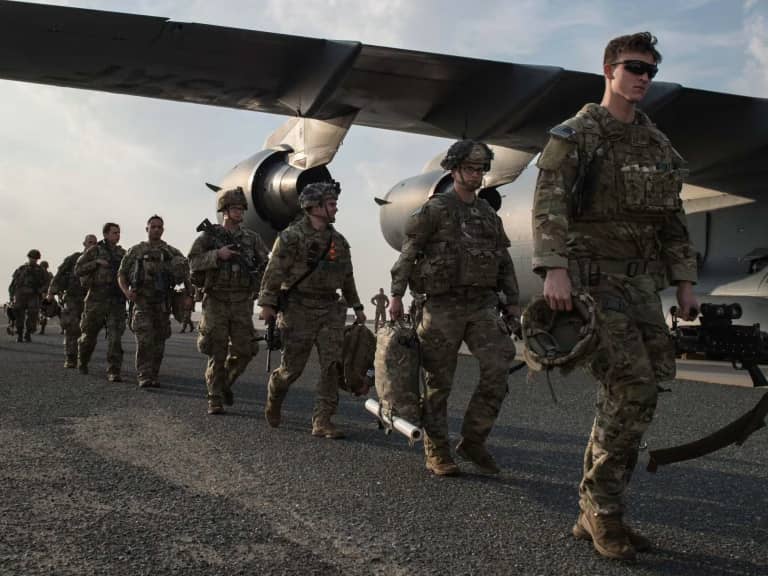President Donald Trump confirmed on Wednesday that the United States is withdrawing personnel from several Middle Eastern countries due to escalating tensions with Iran and the breakdown of nuclear negotiations.
The move affects diplomatic and military staff in countries including Iraq, Kuwait, and Bahrain.
Trump told reporters in Washington that the region is becoming increasingly volatile and described it as “a dangerous place.” He emphasized that the safety of U.S. personnel is a top priority, saying, “We’ve given notice to move out and we’ll see what happens.” The decision reflects mounting fears of a direct conflict with Iran as diplomatic efforts continue to stall.
The withdrawal order comes as nuclear talks between the U.S. and Iran appear to have reached a deadlock. Though five rounds of negotiations have taken place since April, a planned sixth round has not materialized.
In a recent interview with the New York Post, Trump expressed growing doubt about the likelihood of securing a new agreement to replace the 2015 nuclear deal, which he unilaterally withdrew from during his first term in office.
READ ALSO: Biden To Reverse Trump Policies
Reasserting his firm stance on Iran’s nuclear ambitions, Trump declared, “They can’t have a nuclear weapon, very simple. We’re not going to allow that.” Since returning to office in January, Trump has reintroduced his “maximum pressure” strategy, which includes harsh economic sanctions and diplomatic isolation. He has also not ruled out military action, stating that the U.S. remains prepared to act if negotiations fail.
The situation is further complicated by Trump’s communication with Israeli Prime Minister Benjamin Netanyahu. Trump disclosed that he has urged Israel to postpone any military strike against Iran’s nuclear infrastructure, although he hinted that his patience is running out.
In response to the U.S. posture, Iran issued a strong warning. Iranian Defence Minister Aziz Nasirzadeh said that Tehran would retaliate against all U.S. military bases in the region if a conflict begins. “All its bases are within our reach… and without hesitation we will target all of them in the host countries,” Nasirzadeh declared. He expressed hope that diplomatic talks would succeed, but warned that any outbreak of hostilities would inflict greater damage on the United States.
The U.S. maintains several military installations across the Middle East, including a major base in Qatar. These facilities have been potential flashpoints in past confrontations. In 2020, Iran launched ballistic missiles at American bases in Iraq following the killing of Iranian General Qassem Soleimani. That attack resulted in traumatic brain injuries to dozens of U.S. service members.
With the current tensions mounting, the United Kingdom’s Maritime Trade Operations unit has advised commercial ships transiting through the Gulf region to exercise extreme caution. The advisory reflects concerns that any miscalculation could lead to a broader regional conflict.
The underlying issue in the standoff is Iran’s uranium enrichment program. Tehran maintains that its nuclear activities are for peaceful, civilian purposes. However, Iran is now enriching uranium to levels as high as 60 percent purity—well above the 3.67 percent threshold established under the 2015 nuclear agreement. Weapons-grade uranium requires enrichment to 90 percent purity, and although Iran denies seeking a nuclear weapon, its current enrichment trajectory has alarmed Western nations.
Iran’s Supreme Leader Ayatollah Ali Khamenei recently dismissed U.S. objections to the country’s nuclear activities. He called uranium enrichment a “non-negotiable” right and asserted that “Washington cannot have a say.” His comments underscore Iran’s hardline position and suggest little room for compromise in the near term.
Tehran has also criticized the most recent draft proposal from the U.S., arguing that it fails to provide adequate relief from economic sanctions. Iran has promised to submit a counter-proposal, signaling that while talks are not formally over, significant gaps remain between the two sides.
The current developments have raised fears of a potential military confrontation in one of the world’s most volatile regions. Trump’s withdrawal of U.S. personnel appears to be a precautionary measure in anticipation of worsening conditions, while the failure of diplomacy risks plunging the U.S. and Iran into another cycle of hostility.





